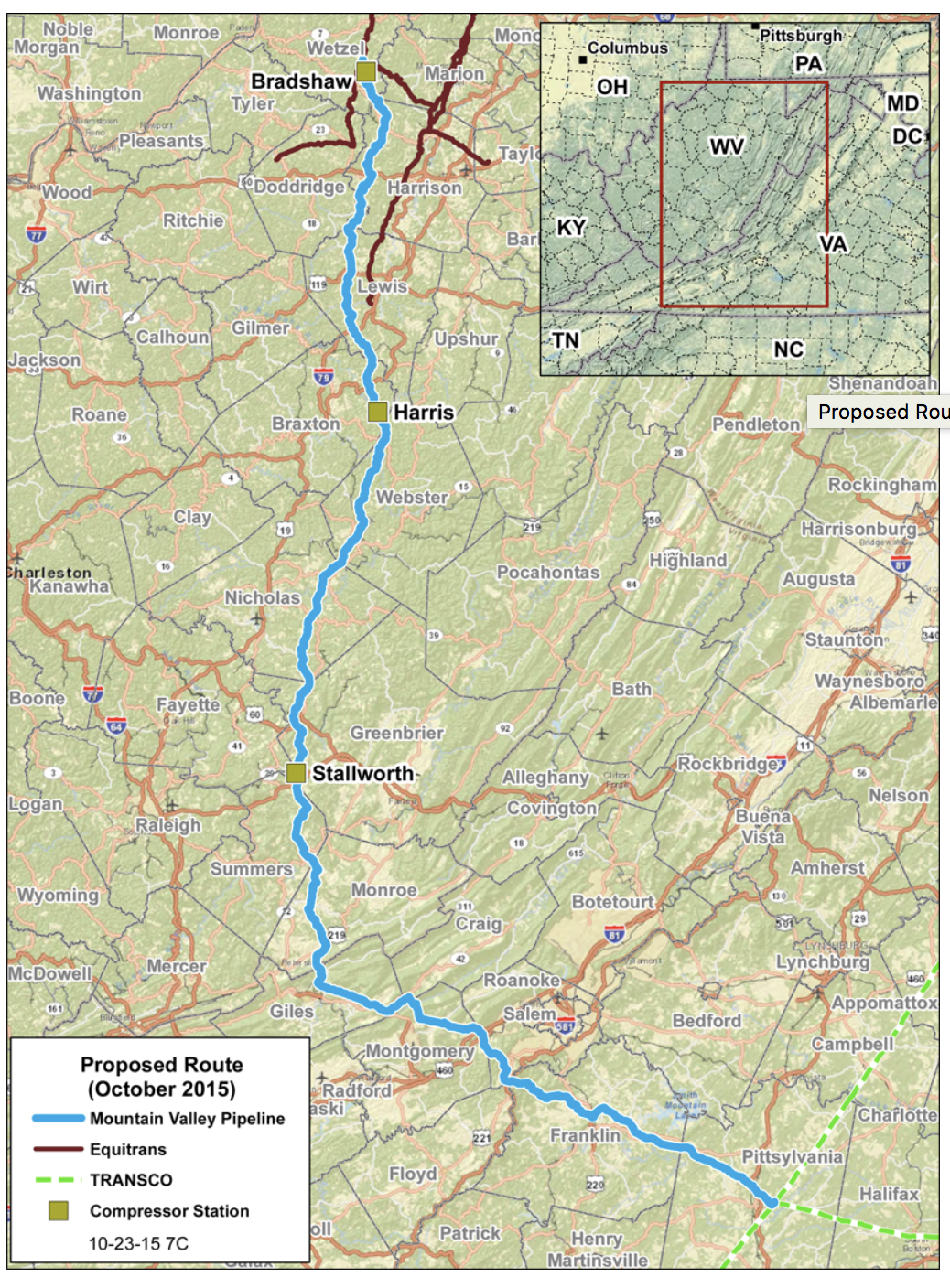FERC Issues Draft EIS for Mountain Valley Pipeline

The Federal Energy Regulatory Commission (FERC) has prepared a draft environmental impact statement (EIS) for the Mountain Valley Pipeline Project.
According to FERC’s statement, while construction and operation of the projects would result in some adverse environmental impacts, these impacts would be reduced with the implementation of the applicant’s proposed mitigation measures and the additional measures recommended in the EIS. FERC’s ruling is based on a review of the information provided by Mountain Valley in their application and supplemental filings in response to staff’s environmental information requests; field investigations; scoping; literature research; alternatives analyses; and consultations with federal, state, and local agencies, and other stakeholders. Although many factors were considered in this determination, according to FERC, the principal reasons are:
- Mountain Valley would implement the measures outlined in the FERC’s Upland Erosion Control, Revegetation, and Maintenance Plan (Plan), its project-specific Wetland and Waterbody Construction and Mitigation Procedures (Procedures).
- In addition, Mountain Valley would implement the measures outlined in its various resource-specific mitigation plans filed with its application to the FERC, or included in various supplemental filings, including its Karst Mitigation Plan and Karst-specific Erosion and Sediment Control Plan to reduce impacts when crossing karst terrain; its Landslide Mitigation Plan for reducing impacts when crossing steep topography; its Mining Area Construction Plan to reduce impacts when crossing coal mine areas; its Draft Blasting Plan to reduce impacts when crossing areas of shallow bedrock; its Organic Farm Protection Plan to reduce impacts when crossing organic farms; its Water Resources Identification and Testing Plan, Spill Prevention Controls and Countermeasures Plan (SPCCP), and Unanticipated Discovery of Contamination Plan to reduce impacts on water resources; its Compensatory Wetland Mitigation Plan to mitigate for the conversion of forested wetlands to shrub or herbaceous wetlands; its Migratory Bird Habitat Conservation Plan and Exotic and Invasive Species Control Plan to reduce impacts on birds, other animals, and plants; its Fire Prevention and Suppression Plan to reduce the chance of wildfires; its Traffic and Transportation Management Plan to reduce impacts on local road users; its Fugitive Dust Control Plan to reduce air quality impacts during construction; and its Winter Construction Plan.
- Mountain Valley would use mostly dry open-cut methods to cross sensitive waterbodies and coldwater fisheries during state-mandated construction windows. They would also obtain permits from the COE and applicable state resource agencies prior to crossing waterbodies and wetlands.
- For the portion of the MVP within the Jefferson National Forest, Mountain Valley would follow the measures outlined in its FS-approved Plan of Development.
- FERC staff would complete formal consultations with the U.S. Fish and Wildlife Service under Section 7 of the Endangered Species Act prior to allowing any construction to begin that could adversely affect federally listed threatened or endangered species.
- FERC staff would complete the process of complying with the National Historic Preservation Act prior to allowing any construction to begin that could adversely affect historic properties.
- FERC staff would provide oversight for an environmental inspection and monitoring program that would ensure compliance with all mitigation measures that become conditions of the FERC authorizations.
In addition, FERC staff and cooperating agencies developed site-specific mitigation measures that Mountain Valley should implement to further reduce the environmental impacts that would otherwise result from construction of their projects. These measures are necessary to reduce the adverse impacts associated with the project and are listed as recommendations in section 5.2 of the EIS.
Comments on the draft EIS must be received in Washington, DC on or before December 22, 2016. Once the final EIS is issued, FERC Commissioners will take into consideration staff’s recommendations when they make a final decision on the project.
This EIS has been prepared in compliance with the requirements of the National Environmental Policy Act (NEPA), under the Council on Environmental Quality regulations for implementing NEPA (40 Code of Federal Regulations [CFR] Parts 1500–1508), and the FERC’s regulations at 18 CFR 380. The United States (U.S.) Department of Agriculture Forest Service (FS), U.S. Army Corps of Engineers (COE), U.S. Environmental Protection Agency, U.S. Department of the Interior Bureau of Land Management (BLM), U.S. Department of Transportation, West Virginia Department of Environmental Protection; and West Virginia Division of Natural Resources participated as cooperating agencies in the preparation of the EIS. Cooperating agencies have jurisdiction by law or special expertise with respect to resources potentially affected by the proposals and participate in the NEPA analysis. The BLM, COE, and FS may adopt and use the EIS when they consider the issuance of a Right-of-Way Grant to Mountain Valley for the portion of the MVP that would cross federal lands. Further, the FS may use the EIS when it considers amendments to its Land and Resource Management Plan for the Jefferson National Forest to allow the MVP to cross the Forest. The conclusions and recommendations presented in the EIS are those of the FERC environmental staff, with input from the cooperating agencies. The agencies will present their own conclusions and recommendations in their respective permit authorizations and Records of Decision for the projects.
Related News
Related News

- Keystone Oil Pipeline Resumes Operations After Temporary Shutdown
- U.S. House Passes Bill to Reverse Biden's LNG Pause
- Biden Administration Buys Oil for Emergency Reserve Above Target Price
- Enbridge to Invest $500 Million in Pipeline Assets, Including Expansion of 850-Mile Gray Oak Pipeline
- Williams Delays Louisiana Pipeline Project Amid Dispute with Competitor Energy Transfer
- Evacuation Technologies to Reduce Methane Releases During Pigging
- U.S. Regulators Approve Mexico Pacific LNG's Saguaro Connector Pipeline
- Editor’s Notebook: Nord Stream’s $20 Billion Question
- Enbridge Receives Approval to Begin Service on Louisiana Venice Gas Pipeline Project
- Russian LNG Unfazed By U.S. Sanctions




Comments